Why does “Shut Door” flash on my GE Double Oven Self-Cleaning Gas oven display?
- MMitchell LeAug 30, 2025
The oven door has been left open. Close the door and normal mode will resume on your GE Ranges oven.

Why does “Shut Door” flash on my GE Double Oven Self-Cleaning Gas oven display?
The oven door has been left open. Close the door and normal mode will resume on your GE Ranges oven.
Why is my GE Double Oven Self-Cleaning Gas Ranges oven smoking excessively during the clean cycle?
If there's excessive smoking during a clean cycle, it's likely due to excessive soil or grease. Press the Cancel/Off pad, open the windows to rid the room of smoke, wait until the LOCKED light goes off, wipe up the excess soil, and then reset the clean cycle on your GE Ranges.
What to do if my GE Double Oven Self-Cleaning Gas Ranges oven does not work?
If your GE Ranges oven isn't working, start by checking the basics: a fuse in your home may be blown, or the circuit breaker tripped. Replace the fuse or reset the circuit breaker. Also, make sure the oven controls are properly set; see the Using the Oven section. Finally, ensure the oven is not in Sabbath Mode; check the Special Features section to verify.
Why does “DOOR” flash on my GE Ranges oven display?
If “DOOR” flashes in the display, it means the self-clean cycle has been selected, but the GE Ranges oven door is not closed. Close the oven door.
What to do when the clock flashes after a power outage on my GE Double Oven Self-Cleaning Gas Ranges?
If there was a power outage or surge, reset the clock on your GE Ranges. If the oven was in use, you must reset it by pressing the Cancel/Off pad, setting the clock, and resetting any cooking function.
Why does food not bake properly in my GE Double Oven Self-Cleaning Gas Ranges oven?
If food isn't baking properly in your GE Ranges oven, several factors could be the cause. First, ensure the oven controls are set correctly. The rack position might be incorrect or not level; refer to the Cooking Modes section and Cooking Guide for proper placement. Also, using incorrect cookware or cookware of an improper size can affect baking. Check the Cookware section for guidance. The oven temperature may need adjustment; see the Special Features section for how to adjust it. Finally, substituting ingredients can alter the outcome of your recipe.
Why is my food not broiling properly in my GE Double Oven Self-Cleaning Gas Ranges oven?
If food isn't broiling properly in your GE Ranges oven, several factors could be the cause. First, make sure you select the appropriate broil mode. Check the Cooking Guide for rack location suggestions. Ensure food isn't being cooked in a hot pan and that your cookware is suited for broiling; use a pan specifically designed for broiling. If using aluminum foil on the broiling pan and grid, make sure it has been fitted properly and slit as recommended. In some areas, the power (voltage) may be low, preheat the broil element for 10 minutes.
How to fix GE Ranges oven light that does not work?
If the oven light in your GE Ranges isn't working, the light bulb may be loose or defective. Try to tighten or replace the bulb. If the pad operating light is broken, call for service.
Why doesn't my new GE Double Oven Self-Cleaning Gas oven cook like my old one?
Your new GE Ranges oven has a different cooking system from your old oven and therefore may cook differently than your old oven. For the first few uses, follow your recipe times and temperatures carefully. If you still think your new oven is too hot or too cold, you can adjust the temperature yourself to meet your specific cooking preference.
What to do if my GE Ranges burners do not light?
If the burners on your GE Ranges do not light, make sure the electrical plug is plugged into a live, properly grounded outlet. Also, the gas supply may not be connected or turned on; see the Installation Instructions that came with your range. If the bridge burner won’t light, see How to Light Bridge Burner section. A fuse in your home may be blown or the circuit breaker tripped; replace the fuse or reset the circuit breaker. Finally, burner parts may not be replaced correctly; see the Care and Cleaning of the range section.
Details about the anti-tip device, its installation, and verification for range safety.
Warning about chemicals in the product known to cause cancer or reproductive harm.
General safety guidelines for using the appliance, covering electrical, installation, and usage precautions.
Precautions to keep flammable items away from the oven to prevent fire hazards.
Steps to take in case of a fire, including extinguishing methods and oven fire procedures.
Safety guidelines specific to operating the cooktop, including unattended burners and oil usage.
Safety guidelines for oven operation, including vent blocking, rack placement, and general usage.
Safety precautions for using the self-cleaning feature, including preparation and operation.
Details of the GE gas range warranty, including coverage, exclusions, and contact information.
List of items and situations not covered by the GE warranty.
Information regarding implied warranties and limitations as per state laws.
Instructions on how to schedule service appointments online or by phone.
Information on ordering parts and accessories for the appliance.
Listing of available accessories like broiler pans and oven racks.
Guide on safely removing protective film and tape from the appliance.
Guide on how to use and operate the gas surface burners.
Step-by-step instructions for safely igniting the surface burners.
Guidelines for selecting and using appropriate cookware for the cooktop.
Warning against using aftermarket stove top grills due to combustion hazards.
Instructions and safety precautions for using a wok on the cooktop.
Procedure for lighting surface burners during a power outage.
Detailed instructions and safety warnings for operating the griddle.
Steps for correctly placing the griddle on the cooktop's oval burner.
Guidance on preheating the griddle before cooking.
Overview of the oven control panel layout and button functions.
Diagram and labels for the oven controls in non-convection mode.
Diagram and labels for the oven controls in convection mode.
Explanation of the oven air vents and the importance of not blocking them.
Explanation of features like temperature adjustment, timer signals, and clock display.
How to adjust the oven's baking temperature up or down.
How to set the oven's timer signal tone (continuous or beep).
How to switch the oven display between Fahrenheit and Celsius.
Options for displaying the time of day (12-hr, 24-hr, or off).
How to adjust the volume of oven tones and alerts.
How the feature automatically adjusts recipe temperatures in convection mode.
Information on the auto shut-off feature and Sabbath mode operations.
Information on oven rack positions and how to adjust them for better cooking.
Instructions for placing and removing standard oven racks.
Details on how to use, remove, and replace extension racks.
Step-by-step guide for removing extension racks from the oven.
Step-by-step guide for replacing extension racks in the oven.
Description of various oven cooking modes like Bake, Broil, Warm, and Convection.
Instructions for using the Bake mode for baking and roasting.
How to use the Warm mode to keep food hot for extended periods.
General safety and usage tips for broiling in the upper oven.
Instructions for using the Broil Hi mode for searing foods.
Instructions for using the Broil Lo mode for thorough cooking and browning.
How to use the Convection Bake Multi Rack mode for baking on multiple racks.
How to use the Convection Roast mode for roasting large cuts of meat.
Guidelines and advice on selecting and using cookware for the oven.
Factors affecting baking performance, like material, finish, and size of cookware.
Warnings and guidelines for the proper use of aluminum foil in the oven.
A guide with recommended modes, rack positions, and suggestions for various food types.
Instructions and precautions for cleaning the oven interior and exterior.
How to clean the oven's control panel and knobs safely.
Cleaning instructions for the oven's exterior and cooktop surfaces.
Specific instructions for cleaning stainless steel surfaces on the appliance.
Manual and steam cleaning methods for the oven's interior.
Steps for manually cleaning the oven interior with mild solutions.
How to use the Steam Clean feature for light oven cleaning.
Detailed instructions for using the Self Clean mode for intensive oven cleaning.
How to clean oven racks, including those used during self-cleaning.
Instructions for cleaning the cooktop, including burner removal.
Steps for removing burner parts for effective cooktop cleaning.
How to clean burner caps and burner heads for optimal performance.
Specific instructions for washing and cleaning the burner caps.
Detailed instructions for cleaning burner heads and ports.
Ensuring burner caps are properly seated on the burner heads for correct operation.
Methods for washing and cleaning burner grates, including ammonia soak.
Instructions for cleaning grates using the oven's self-clean cycle.
Information on replacing and inserting grate support bumpers.
Cleaning instructions for non-stick aluminum and cast-iron griddles.
Specific cleaning advice for the non-stick aluminum griddle.
Cleaning instructions for the cast-iron reversible griddle.
Safety precautions related to spills and grease under the griddle.
Instructions for cleaning the inside and outside of the oven door.
Detailed steps for cleaning the oven door glass and gasket area.
General maintenance procedures for the appliance.
Safety warnings and steps for replacing the oven light bulb.
Detailed guide on how to safely replace the oven light bulb.
Instructions for removing and lifting off the lower oven door.
Step-by-step instructions for safely removing the lower oven door.
Step-by-step instructions for safely replacing the lower oven door.
Instructions for removing and lifting off the upper oven door.
Step-by-step instructions for safely removing the upper oven door.
Step-by-step instructions for safely replacing the upper oven door.
Addresses differences in cooking performance compared to older ovens and temperature adjustments.
Common causes and solutions for improper baking results.
Troubleshooting tips for issues with the broiling function.
How to address oven temperature inaccuracies.
Steps to take if the oven is not functioning at all.
Explanation for normal crackling or popping sounds during oven operation.
Explanation for normal clicking noises related to temperature control.
Troubleshooting steps for non-functional clock and timer features.
Reasons for longer preheat times and how to optimize them.
Tips for achieving even cooking results, especially with multiple racks.
Reasons why the self-clean cycle might not start.
What to do if excessive smoke occurs during the self-clean cycle.
Troubleshooting for smoke during broiling operations.
How to open the oven door if it remains locked after self-cleaning.
Solutions if the oven is not clean after running the self-clean cycle.
Troubleshooting the "DOOR LOCK" indicator.
How to disable the lock feature if it prevents cooking.
Interpreting error codes that flash in the display.
Troubleshooting a blank display, possibly due to a fuse or breaker.
How to exit or manage Sabbath Mode if it's causing issues.
What to do after a power outage affects the clock and cooking.
Explanation for odors emitting from the vent during operation.
How cooking modes behave when the oven door is left open.
Troubleshooting for burners not lighting or burning unevenly, including normal flame variations.
Causes and solutions for burner flames appearing large or yellow.
Steps to take if surface burners work but the oven does not.
Troubleshooting for surface burners failing to ignite.
How to disable the control lockout feature to use the range.
Explanation for the "TURN BURNERS OFF" message and its resolution.
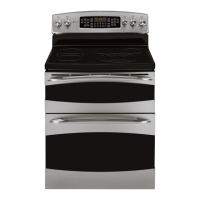


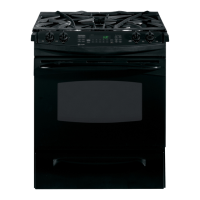

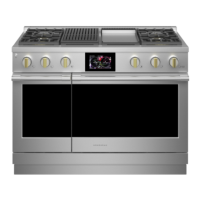
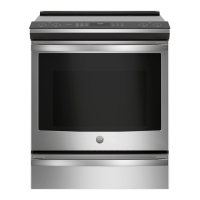



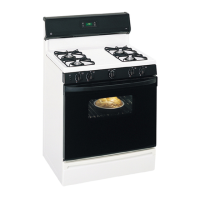

